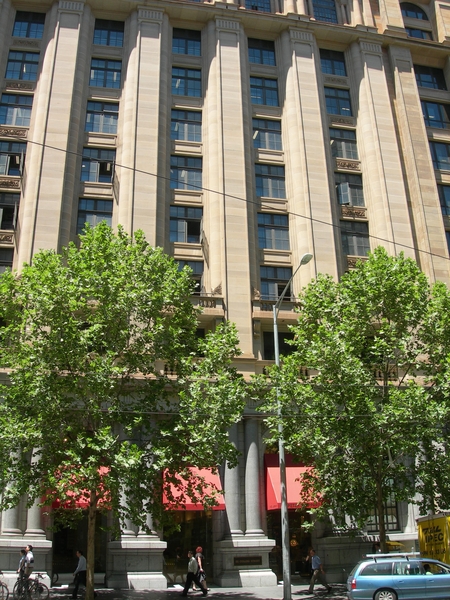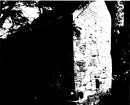FORMER NATIONAL BANK OF AUSTRALASIA HEAD OFFICE
271 - 285 COLLINS STREET MELBOURNE, MELBOURNE CITY
-
Add to tour
You must log in to do that.
-
Share
-
Shortlist place
You must log in to do that.
- Download report







Statement of Significance
What is significant?
The former Head Office of the National Bank of Australasia at 271-285 Collins Street was the second head office building erected on this site by the bank. The first, designed by architect Lloyd Tayler, opened in 1870. In 1924-5 the architects A & K Henderson won the competition for the design of a new building, designing a 5 bay, 10 storey steel framed structure with reinforced concrete floors. The building rose to the maximum permitted height limit, 132ft (40.2m). The design is that of a stretched commercial palazzo, with a strongly emphasised base and top storey linked by relatively neutral successive floors, but in this instance deliberately echoing the design of the earlier two storey building. The ground floor of the original building was repeated in the new ground floor, comprising pairs of polished Harcourt granite Tuscan/Doric columns, and carved masks over the arched openings. The Palladian windows of the first floor were reproduced on the new top floor, separated by seven storeys of multi-paned steel framed windows flanked by giant order pilasters faced with Hawkesbury sandstone. The new building was officially opened in October 1927. In 1930 the building was voted by readers of the Herald newspaper as one of the two most handsome buildings in the city.
The entrance is via steps leading up from Collins Street to the three central arched openings and three massive sliding bronze doors. The banking chamber is a voluminous space, approximately 43m deep, 26m wide and more than 8m high. It is artificially lit by a large T-shaped lead skylight below the central light court. The elaborate coffered plaster ceiling is supported by clustered giant order pillars with Corinthian inspired capitals. Ionic columns support the encircling balustraded mezzanine gallery, which is accessed by a grand divided marble staircase at the south end of the chamber which was added in the 1930s and is located on axis with the entrance. In the chamber there was a Women's Bank, an innovation at the time. The banking chamber has been altered a number of times, most notably in the 1930s to include the staircase and during the 1980s renovations. The second floor contains the boardroom and board dining room, panelled in English Oak and Tasmanian Blackwood, and with elaborate coffered plaster ceilings. In the basement are the series of strongrooms, with original Chatwood Patent strongroom doors.
The building underwent major alterations in the 1980s when the bank merged with Commercial Banking Company of Sydney to create the National Australia Bank. Alterations, which included the major but sympathetic three bay addition at 285 Collins Street, left the 1920s facade intact. Fabric that has been removed around the entrance includes the original entrance hall with swing doors, observation gallery and associated stairs and lifts, some of which was probably removed when the marble staircase was added.
How is it significant?
The former Head Office of the National Bank of Australasia is of architectural and historical significance to the State of Victoria.
Why is it significant?
The former Head Office of the National Bank of Australasia is architecturally significant as an outstanding example of the stretched commercial palazzo style. The stretched palazzo style, a common enough style in early twentieth century Melbourne buildings, is unusual in this instance for the strong Renaissance revival overlay in contrast to the more typical stripped classicism of the period. The imposing, classically styled entrance underlines the institutional nature of the bank, whilst the composition as a whole makes an elegant contribution to Collins Street at a time when architects and critics were increasingly concerned about the contribution new buildings made to the existing streetscape. It received popular acclaim in 1930 from the readers of the Herald newspaper. Internally the banking chamber has been altered, but remains an impressive and elaborate twentieth century space. The board room and dining room (together with the associated furnishings) are interesting surviving examples . The building is also significant for its associations with the architectural firm of A & K Henderson. Under the direction of Kingsley Henderson the firm specialised in commercial and banking structures and achieved great acclaim for their designs, particularly along Collins Street.
The former Head Office of the National Bank of Australasia is historically significant as the former headquarters of one of Australia's major banks. It was the second head office constructed on this site in Collins Street. The building was a symbol of confidence as Australia entered the Depression of the late 1920s. The building is historically significant for its associations with the Women's Bank, an innovation for women to conduct their banking in private.
-
-
FORMER NATIONAL BANK OF AUSTRALASIA HEAD OFFICE - History
Associated People:
FORMER NATIONAL BANK OF AUSTRALASIA HEAD OFFICE - Permit Exemptions
General Exemptions:General exemptions apply to all places and objects included in the Victorian Heritage Register (VHR). General exemptions have been designed to allow everyday activities, maintenance and changes to your property, which don’t harm its cultural heritage significance, to proceed without the need to obtain approvals under the Heritage Act 2017.Places of worship: In some circumstances, you can alter a place of worship to accommodate religious practices without a permit, but you must notify the Executive Director of Heritage Victoria before you start the works or activities at least 20 business days before the works or activities are to commence.Subdivision/consolidation: Permit exemptions exist for some subdivisions and consolidations. If the subdivision or consolidation is in accordance with a planning permit granted under Part 4 of the Planning and Environment Act 1987 and the application for the planning permit was referred to the Executive Director of Heritage Victoria as a determining referral authority, a permit is not required.Specific exemptions may also apply to your registered place or object. If applicable, these are listed below. Specific exemptions are tailored to the conservation and management needs of an individual registered place or object and set out works and activities that are exempt from the requirements of a permit. Specific exemptions prevail if they conflict with general exemptions. Find out more about heritage permit exemptions here.Specific Exemptions:General Conditions: 1. All exempted alterations are to be planned and carried out in a manner which prevents damage to the fabric of the registered place or object. General Conditions: 2. Should it become apparent during further inspection or the carrying out of works that original or previously hidden or inaccessible details of the place or object are revealed which relate to the significance of the place or object, then the exemption covering such works shall cease and the Executive Director shall be notified as soon as possible. Note: All archaeological places have the potential to contain significant sub-surface artefacts and other remains. In most cases it will be necessary to obtain approval from Heritage Victoria before the undertaking any works that have a significant sub-surface component. General Conditions: 3. If there is a conservation policy and plan approved by the Executive Director, all works shall be in accordance with it. Note: The existence of a Conservation Management Plan or a Heritage Action Plan endorsed by Heritage Victoria provides guidance for the management of the heritage values associated with the site. It may not be necessary to obtain a heritage permit for certain works specified in the management plan. General Conditions: 4. Nothing in this declaration prevents the Executive Director from amending or rescinding all or any of the permit exemptions. General Conditions: 5. Nothing in this declaration exempts owners or their agents from the responsibility to seek relevant planning or building permits from the responsible authorities where applicable. Minor Works : Note: Any Minor Works that in the opinion of the Executive Director will not adversely affect the heritage significance of the place may be exempt from the permit requirements of the Heritage Act. A person proposing to undertake minor works may submit a proposal to the Executive Director. If the Executive Director is satisfied that the proposed works will not adversely affect the heritage values of the site, the applicant may be exempted from the requirement to obtain a heritage permit. If an applicant is uncertain whether a heritage permit is required, it is recommended that the permits co-ordinator be contacted.FORMER NATIONAL BANK OF AUSTRALASIA HEAD OFFICE - Permit Exemption Policy
The purpose of the permit exemptions is to allow works which do not impact on the significance of the place to occur without the need for a permit. Following the 1980s redevelopment the following earlier elements were left mainly intact: the facade, the ground floor banking chamber with marble stair, mezzanine and lantern, the basement with strongrooms, and the second floor board room, dining room and vestibule. The remainder of the building was effectively gutted, (including removal of the west wall to enable connection to the new building at 285 Collins Street) leaving only concrete floors and walls. These floors have been subject to any number of refits.
All works to the building not impacting the significant areas identified above are exempt from the need for permits
-
-
-
-
-
FORMER ROYAL AUSTRALIAN ARMY MEDICAL CORPS TRAINING DEPOT
 Victorian Heritage Register H0717
Victorian Heritage Register H0717 -
MITRE TAVERN
 Victorian Heritage Register H0464
Victorian Heritage Register H0464 -
MELBOURNE SAVAGE CLUB
 Victorian Heritage Register H0025
Victorian Heritage Register H0025
-
'The Pines' Scout Camp
 Hobsons Bay City
Hobsons Bay City -
106 Nicholson Street
 Yarra City
Yarra City -
12 Gore Street
 Yarra City
Yarra City
-
-
Notes See all notes
rohan storey • 13/05/15
In the chamber, the marble stairs have been removed, the corinthian column capitals restored, and the ground level subdivided with glass partitions to form shop areas. Glass display cases have been inserted in the facade beneath the windows of the ground level.
Public contributions
Notes See all notes
rohan storey • 13/05/15
In the chamber, the marble stairs have been removed, the corinthian column capitals restored, and the ground level subdivided with glass partitions to form shop areas. Glass display cases have been inserted in the facade beneath the windows of the ground level.












